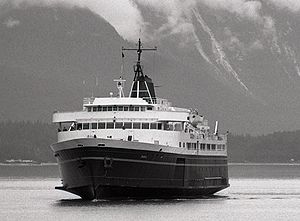MV Taku
 MV Taku | |
| Career | |
|---|---|
| Name: | M/V Taku |
| Namesake: | Taku Glacier, Juneau, Alaska |
| Owner: |
|
| Port of registry: |
|
| Builder: | Puget Sound Bridge & Dry Dock Company, Seattle, Washington |
| Launched: | 1963 |
| Commissioned: | 1963 |
| Status: | in active service, as of 2025[update] |
| General characteristics | |
| Class and type: | Malaspina-class mainline ferry |
| Displacement: | 4,283 long tons (4,352 t) |
| Length: | 352 ft (107 m) |
| Beam: | 74 ft (23 m) |
| Draft: | 16 ft 11 in (5.16 m) |
| Decks: | One vehicle deck |
| Ramps: | Aft, port, and starboard ro-ro loading |
| Propulsion: | 8,122 hp (6,057 kW) |
| Speed: | 16.5 knots (30.6 km/h; 19.0 mph) |
| Capacity: |
450 passengers 69 vehicles |
| Crew: | 42 |
M/V Taku is a Malaspina-class mainline vessel for the Alaska Marine Highway System.
Constructed in 1963 by the Puget Sound Bridge & Dry Dock Company in Seattle, Washington, the M/V Taku is named after Taku Glacier which is located just southeast of Juneau, Alaska and has been in the ferry system for over forty years. In 1981, the Taku received a major refurbishment and has been in service steadily since although there was talk of retiring the vessel in 2003. As a mainline ferry, which means in serves the larger of the inside passage communities (such as Ketchikan, Petersburg, and Sitka), its route primarily stays between Ketchikan and Skagway meaning it only serves in Southeast Alaska.
The Taku's amenities include a hot-food cafeteria; bar; solarium; forward, aft, recliner, movie, and business lounges; gift shop; 8 four-berth cabins; and 36 two-berth cabins.
The M/V Taku is the largest of the three AMHS vessels able to serve the communities of Hoonah and Kake and because of this served as a critical component of providing transportation out of Hoonah and Kake after the "milk run" ferry, the M/V LeConte hit a rock and went into dry dock.
External links
| |||||||||||||||||

